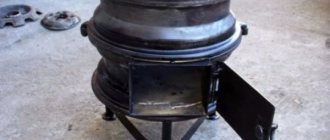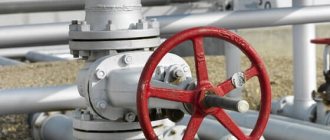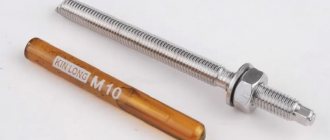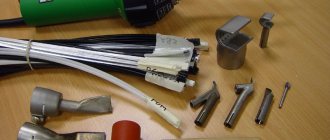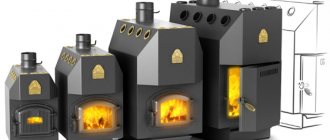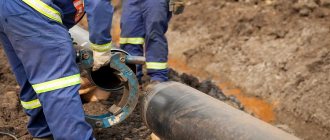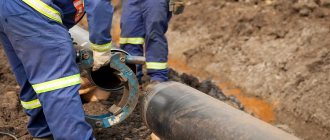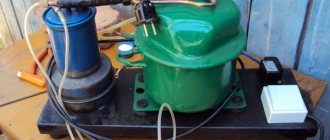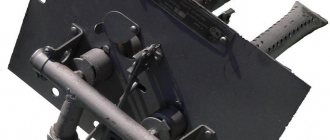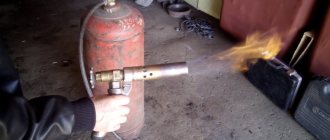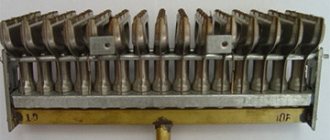SHARE ON SOCIAL NETWORKS
FacebookTwitterOkGoogle+PinterestVk
The gas burner for roofing work is designed to melt the bitumen coating and waterproof the roof during repair work. The tool is also used for drying concrete and brick, heating metal and plastic when bending. To operate the device, a cylinder with working gas is required. Features of the work, choice of tools and recommendations for creating a structure with your own hands - all this information is contained in the article.
A torch for roofing work is usually a torch with a hose and a fuel cylinder
Gas burner for roofing work: what is it?
Very often, during roofing installation and repair work, it is necessary to heat or dry the material, for example, when laying a waterproofing layer, to create a soft roof or to melt bitumen mastic. A roofing gas burner will help to complete these tasks. Using this device, you can perform several types of operations, namely:
- drying surfaces and materials;
The flame is controlled using regulators installed on the device
- cutting or soldering metal parts;
- burning and removing the old paint layer;
- sealing small cracks;
- melting bitumen-based mastic;
- heating sheets of material before laying;
- strengthening of seams and joints;
- other work that requires the use of high temperature.
A roofing torch is usually a torch with a hose and a fuel container. This design is very convenient, reliable and mobile. The volume of the gas cylinder can be different, the hose with the torch has a standard appearance. The flame is controlled using regulators installed on the device.
This is interesting! A roofing gas burner is a specialized gas-air type unit that is used for installation and dismantling of soft roofing coverings, as well as for drying various building structures.
A gas burner is needed to perform those jobs that require the use of high temperature
Scope of application after modification
Gas burners are used in households and agriculture, during construction and repair work, when repairing vehicles and equipment,
In addition to the listed areas, gas appliances are used for the following purposes:
- installation of heat shrink tubes;
- melting the solder before soldering;
- heating metal water pipes;
- heating bitumen for roof repair.
In addition to the above, the device is used for removing paintwork by firing the surface, for welding materials whose melting point is about 1000 C. With its help, you can cook or heat food or boil water for tea right on the construction site.
Propane burners: professional and budget models
Experienced foremen usually buy expensive professional models, which are reliable and safe to use. But for a self-taught craftsman, simple and small designs are quite suitable for home use. Let us consider further how the choice of this or that equipment will affect the quality of work.
A simple burner is not intended for industrial work, where it must be used almost every day. In this case, you will need a reliable model that can withstand uninterrupted operation and guarantee absolute safety. At the same time, a cheap and simple design in the hands of a skilled and careful craftsman can last for several decades. Especially if you have to use it only once a season.
Regardless of which product is chosen: an expensive and professional burner with a cylinder or a cheap household design, before each use it is necessary to check the tightness of the product, especially the connection points, the fuel supply hose and the mouthpiece for clogging. If you miss even a minor defect, you can provoke serious problems.
Propane burner is very convenient, reliable and mobile design
Helpful advice! Even for home use, you should not buy the cheapest burner. Most likely, this model will have a weak gearbox, which means that the tool’s performance will be on par with the power of a blowtorch. Working with such a device will be very slow.
Conclusions and useful video on the topic
A few secrets to improve the performance of the forge:
- The back wall with a cutout will improve ventilation and make it possible to work with long workpieces.
- A metal stand for the forge will make work more convenient.
- To work with workpieces of different sizes, it is more convenient to use several forges of different sizes standing next to each other. Air is supplied using flexible hoses for quick switching between burners.
- Each “main” must have shut-off valves. For smooth adjustment, ball valves should be abandoned.
Having at hand a small supply of tools, a gas burner diagram and the necessary materials, every home craftsman can assemble a propane burner. It is important to follow fire safety rules and use only high-quality materials approved for use in the domestic gas supply system. But if you are not confident in your own abilities, it is better to purchase such a device in a store.
If you had to assemble a propane burner yourself, please share your knowledge with our readers and tell us which option you chose. Why was he chosen and were there any difficulties during the work process? Perhaps you have a diagram of the device and a photo of the finished homemade product - include visual information in the discussion of the material.
Gas burner for roofing on a cylinder or can
At first glance, it may seem that pulling a gas cylinder onto the roof is the most dangerous idea, especially since there are a lot of hand-held burners on sale. In fact, it is the canister burners that often cause burns, fires and injuries. This is due to the sale of fake and cheap Chinese products. The safety of burners with a large cylinder lies in the fact that the container itself is located far from the flame during operation.
When purchasing, do not pay attention to too cheap models. The main problem with such structures is that the technical data sheet indicates an operating pressure of 0.05-0.08 MPa, which during operation turns out to be several times higher. The gearbox installed on the device is absolutely not designed for heavy loads, so a closed valve may simply not withstand such stress.
Gas burners on a can have a combustion temperature of about 700-1000 °C
Gas burner for a cylinder: characteristics of the device
The design of the gas burner includes a handle, a gas supply tube and a metal cup attached to its end. A hose is connected to the handle, through which the working gas is supplied from the gas cylinder. The handle can be made of plastic or wood.
The gas burner bowl is designed in such a way that the flame is protected from the wind during operation. Glasses of different models have different devices, but their operating principle is the same. It is also possible to adjust the flame length. Modern models are equipped with a special gearbox, on which, using a valve, you can control the pressure and fuel consumption.
By pressing the handle lever, the valve opens and gas enters the glass through a tube and hose. The flammable mixture of working gas and air is ignited with a lighter or with ordinary matches. The combustion temperature of a gas burner is very high and can reach from 500 to 1500 °C.
Absolutely all models of gas roofing burners are equipped with an atmospheric air supply system. There is also a device for adjusting operating modes: operating mode and standby mode. For the manufacture of devices, only high-quality and very durable materials are used, since the burner heats up to the highest temperatures. Typically, the weight of the structure is small and varies from 1 to 1.5 kg, so the tool is easy to hold in your hands.
By pressing the handle lever, the valve opens and gas enters the glass through a tube and hose
Modern roof burners differ from each other in the principle of adding oxygen to the fuel. Older models require connection to an oxygen cylinder, which is not entirely convenient. Modern designs take air from the atmosphere. Typically, propane is used as the burner gas, but there are samples that run on pure methane.
It is important! The length of the handle for holding the gas burner should measure about one meter, but no more. In this case, it is necessary that it be equipped with a special holder made of heat-resistant plastic or high quality wood, thanks to which the master’s hands are protected from burns.
Gas burners on a can: description of the tool
The burner in the form of a nozzle on a gas cylinder with a collet connection is used only in strict compliance with fire safety rules, as well as in places where heavy construction equipment is not working and the risk of damaging the burner with the cylinder is minimal.
The simplest models have a combustion temperature of about 700-1000 °C. Oxygen enters the burner from the air, so it is always in short supply. In tools that have a higher cost, the flame temperature reaches 1200 °C, and they have a specific shape of air supply holes that help increase the amount of oxygen in the burner.
Gas burners on a can are equipped with a flexible or rotating tube and a valve for adjusting the flame
Manual gas burners of the ejector type have an even higher flame temperature. In these structures, air flows to the fire due to rarefaction. Thanks to this, the flame reaches a temperature of 1500-1600 °C. It is also possible to regulate the flame length relatively smoothly using a tap. This model is not designed for delicate work, but is great for heating large areas.
All types of gas burners are equipped with a flexible or rotary tube, piezo ignition and a highly sensitive valve for adjusting the flame. Currently, there is a large selection of tools according to their power and fuel consumption.
Gas burner for soldering: features of models
Ejector lamps for soldering have a special design and purpose. Most often, these tools are used by craftsmen for processing non-ferrous metals. The high temperature and adjustable flame of the torch make it ideal for soldering and hardening of metals or any other heat treatment that requires high temperature accuracy and a clearly defined flame cone.
Gas torches are most often used for processing non-ferrous metals
The sizes of canister burners and nozzles can vary significantly, which allows them to be used in various fields. Very miniature models are used for soldering jewelry and thin metal. Although the tool is not equipped with a device for supplying oxygen, it does an excellent job of filigree work.
Medium type devices have a cone thickness of 0.3 to 0.9 cm and are optimally suited for soldering copper and aluminum tubes. Due to their high power, large burners should be used in artistic forging or metal stamping.
For ejector burners, the use of the concept of an unstable flame is not entirely correct. Since, although flashes are possible from time to time, this has little effect on the temperature in the core of the instrument’s flame.
Mini
A very tiny gas burner can be made from a fitting for inflating basketballs, a syringe needle and a couple of droppers, or as they are called medical “systems” for drip administration of drugs. The homemade product can even work from a lighter refill can.
Adjusting roller clamps will act as valves.
True, we will need a forced air supply for this device; the nozzle diameter is too small for injection of atmospheric air. For this purpose, you can use the compressor of an aquarium or an old refrigerator.
Carefully grind off the tip of the syringe needle and fitting. After this, bend the syringe needle slightly and insert it into the side hole of the fitting, so that the end comes out slightly from the cut tip.
We wrap the needle insertion site with copper wire and solder it well with acid.
The burner is ready. All that remains is to connect gas and air to it.
Gas burner for roofing: laying material
Very often, roofing felt is used in roofing work, and it is impossible to create high-quality waterproofing from this material without a gas burner. You will also need a tool to cover the roof with welded types of modern materials.
When laying roofing felt on the roof, you can’t do without a hay burner.
The entire process of working with the burner can be divided into several stages:
- First, the preparation of the base for laying the coating is organized; for this it is necessary to clear it of debris. If necessary, you can level the surface using a screed.
- The entire surface is covered with rolled material so that adjacent sheets form an overlap 8.5-9 cm wide.
- Having leveled the material and completed the markings, the rolls are rolled back and secured at the base of the roof using a torch. To do this, the lower part of the roll and the base of the roof are heated with a flame, after which the roll of material is slowly unrolled and pressed against the base.
- To prevent the appearance of wrinkles and air bubbles, it is necessary to walk over the attached canvas with a hand roller.
- At the final stage, you should also use a burner, with which the seams of the material are heated. After this, they also need to be compacted with a hand roller.
Before using the roof burner, you need to familiarize yourself with several important points:
- Do not use the device at a temperature of 15 degrees below zero;
- if roofing work is carried out at low temperatures, then it is allowed to use a liquid fuel burner;
Before using the roof burner, you need to familiarize yourself with several important rules
- the use of a gas burner with high technical characteristics for roofing makes it possible to lay about 500-600 m of roofing material per day;
- Since the process takes place in the open air, the burner must operate smoothly and have reliable protection from being blown out by the wind.
Related article:
Petroleum bitumens for construction and roofing (GOST)
Bituminous material provides waterproofing of complex structures where other materials cannot be used.
Gas burner: price and characteristics of some popular models
Gas-air burners for roofing are the safest tools. They are easy to use, lightweight, and capable of creating a flame of sufficiently high power. Modern manufacturers offer models that operate without oxygen:
- GG-2 – propane burner for the roof. This is the best option for craftsmen who perform repair work themselves. It has an acceptable cost;
- GG-2U is a device similar to the previous version, but this model is characterized by a shortened version of the gas supply hose for the gas burner. This device is ideal for performing work in hard-to-reach areas of the roof, as well as for gluing joints;
Before purchasing a burner, it is important to read the specifications of the model and check the quality certificates
- GG-2S is a model that belongs to professional tools and runs on propane. The main advantage of the device is that the device can be used even in strong winds. The device is equipped with two valves and consists of two housings, making it easier to control the operating modes of the device;
- GGS1-1.7 is a universal design, which, despite its small size and weight, is characterized by a high degree of performance. The device can only be used on flat horizontal areas;
- GGK-1 - this burner is heavier than previous designs and is equipped with a very durable glass. This model is suitable for burning old paint, wooden surfaces, as well as for performing waterproofing work. Fuel is supplied using a special lever.
- GGS1-1.0 is used for small works of insignificant volumes. Optimally used on roofs with a large angle of inclination;
- GGS1-0.5 is used for minor repair work. The model is characterized by low fuel consumption;
- GGS4-1.0 consists of four bells, thanks to which the entire roll is heated simultaneously. The use of this option allows you to increase labor productivity and save fuel;
Gas-air burners for roofing are considered the safest tool
- GV-3 is a propane torch designed for welding and even manual soldering of metal. The diameter of the glass is 5 cm;
- GV-111R is used for melting bituminous materials and firing a layer of paint.
- GV-550 and GV-900 are very easy-to-use designs that differ from each other only in the maximum flame length. The first model is more suitable for performing tasks at the junction points of the roof, and the second device allows you to work while standing at full height, since the length of the torch reaches 90 cm;
- GV 500 is used to perform surfacing work during laying of roofing materials. This model melts bitumen with ease. The flame temperature of the GV 500 gas burner is 300 °C;
- GV-850 is a burner that has a special valve, thanks to which you can precisely regulate the amount of technical gas supplied from the cylinder. There is also a lever installed here, with which the master adjusts the length of the torch. This gas burner does not operate on pure propane, but on a mixture that contains technical oxygen. The price of a gas burner for roofing GV-850 is 1700-2200 rubles.
As you can see, the choice of gas burners is very wide, and where to buy a burner: in a store or on the website depends on the wishes of customers. The main thing is to read the specifications of the model and check the quality certificates for the product.
Helpful advice! GV class models are suitable for heating non-ferrous and ferrous metals, melting bituminous materials in rolls when performing waterproofing and roofing work, as well as in cases where the use of only propane is required.
Gas burners are easy to use, lightweight, and capable of creating a flame of sufficiently high power.
Which is more convenient: long or short?
If you value ease of use, then purchase a lever roofing burner, in which you do not need to constantly tighten and unscrew the valve. But how long should the handle be?
Thus, the length of the burner is not a style, but an important functional point: short ones, which do not exceed half a meter in length, usually make partial repairs, heat up individual areas and melt the necessary areas of the roof. But for larger-scale work, you will need a burner with a length of at least 80 cm.
How to use a gas burner: safety rules
The operation of gas burners requires strict adherence to safety rules:
- Work with burners is carried out in special clothing and shoes with non-slip soles. You will also need a belt and walking bridges.
- Before using the tool, it is necessary to conduct an external inspection and ensure that the burner, cylinders and connecting hoses are in full working order.
- During use of the device, only one gas cylinder may be present at the work site.
- Do not stand in front of the nozzle while igniting the gas in the burner. The direction of the metal cup must be such that the fire cannot touch anyone nearby, the gas cylinder and the connecting hoses.
- If you use weldable materials, you must ensure that they do not overheat and do not catch fire. It is necessary to ensure that only the lower part is heated; the material should not be allowed to soften completely.
- The burner can only be lit with matches or a lighter.
- While working with the device, the master is prohibited from going beyond the boundaries of the workspace, as well as going down or up the scaffolding.
Extinguishing the tool occurs in two stages: first, the gas supply is shut off, and then the locking lever is released. Even after a short break in operation, the device should be extinguished. If there is a significant break, then the gas supply must be shut off at the cylinder itself.
Before using the gas-air burner, it is necessary to conduct an external inspection and ensure that it is in full working order.
Helpful advice! If the mouthpieces or connecting hoses are clogged, the device cannot be used, as kickback and popping noises may occur. If backlash occurs or the equipment overheats, you should immediately stop working and turn off the fuel supply to the cylinder. You can cool the instrument by immersing it in a container of water.
